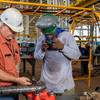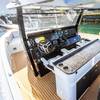Austal HY profit slides
Revenue of $649.2 million (FY2016 H1: $747.4 million)
Underlying EBIT of $31.2m after excluding arbitration settlement related to 7-year-old claim.
Headline EBIT of $18.1 million (FY2016 H1: $29.0 million)
Net profit after tax of $9.3 million (FY2016 H1: $16.8 million)
Earnings growth from US shipyard. Lower throughput in Australian shipyard, as anticipated.
Fully franked interim dividend of 2.0 cents per share (FY2016 H1: 2.0 cents per share)
Order book $3.128 billion across 11 vessel programs
Bidding largest ever single Australian contract with German ship designer Fassmer for Australian Government’s $3 billion, 12 ship, Offshore Patrol Vessel (OPV) program
Submitted largest ever company bid for up to a further 13 Littoral Combat Ships, with at least one expected to be awarded and funded in CY2017
Underlying full year FY2017 EBIT is expected to be in the range of $55 – 60 million which is above the guidance given previously
Austal Limited today reported its results for the six months ended 31 December 2016, with a Net Profit After Tax of $9.3 million.
Austal’s financial engine room in the USA, delivered a strong turnaround in earnings, with segment EBIT up 53% on the prior corresponding period (“pcp”) to $41.1 million. The earnings contribution from the Australian shipyard was lower than the half year prior as anticipated, as major vessel programs progressed through their design phase. Earnings at the Group level, were impacted by a one-off event of a $13.2 million provision relating to the recent settlement of an arbitration matter from a commercial vessel delivered seven years ago. Austal Chief Executive Officer David Singleton said the result demonstrated the benefit of Austal’s global scale.
“Austal’s diversity across geographies and vessel programs meant the Company was able to deliver a profit and maintained dividends to shareholders despite two of our shipyards being in a transition period” Mr Singleton said.
“Earnings from the US shipyard bounced back strongly from FY2016, with the performance on our two multi-billion-dollar navy vessel programs improving as each ship is delivered.”
“This performance in the USA offset the expected lower result from our Australian shipyard which is in a transition year. The 21-vessel, $305 million, Pacific Patrol Boat program and a circa $90 million, 109-metre ferry have been going through their design phase although construction on these ships will have commenced by the end of the financial year.
“Our Philippines shipyard ran below full capacity in the half due to the delay of an expected order related to customer financing. We remain confident that this will be a temporary issue given the very strong pipeline of new enquiries from around the world which is running at levels not seen since
before 2008.”
SEGMENT RESULTS
USA
Austal’s USA segment reported revenue of $594.3 million (FY2016 H1: $638.4 million), with a segment EBIT of $41.1 million (FY2016 H1: $26.9 million). This was driven by work on thirteen ship construction projects across Austal’s two major vessel contracts for the U.S. Navy; the ~US$4 billion Littoral Combat Ship (LCS) contract and ~US$1.9 billion Expeditionary Fast Transport (EPF) contract.
Revenue in the support business has continued to grow, up 78% on the same period to $55.8 million. The EBIT margin on support at 12.5% was above our normal expectations as a result of the benefit of profit awarded by the US Navy in FY017 H1 that related to FY2016 activity. Nonetheless overall profit margins in support are continuing to improve.
USA shipbuilding EBIT margin was 6.6% per cent, in line with the Company’s previous guidance of 5 – 7%. Austal’s confidence in the LCS program continued to grow in FY2017 H1 as the Company moved further along the production learning curve, with findings from the LCS program review completed in July 2016 being progressively implemented. The number of new requested modifications to vessels already well advanced has dropped dramatically and existing required modifications are now being incorporated much earlier in the build cycle which reduces costs. In addition, the shipyards strategy to continually bring forward work normally carried out at the waterfront into the module manufacturing facility is reducing costs and increasing speed particularly in the final stages of build. This approach is allowing Austal to maximise the benefits of its leading edge production facilities designed to facilitate just this approach to construction. However, the company advises that further evidence of progress over at least the next 6 months will be necessary to provide real confidence that the turnaround is complete. Meanwhile, the EPF program, which is utilising the production techniques described above, is performing exceptionally well and above expectations. The program was extended from 10 to 12 ships with the award of 2 additional vessels, extending Austal USA’s contracted production schedule into FY2021 although we would like to see additional orders in the next 18 months to maintain the tempo now being achieved Austal has previously advised that it has made a series of financial claims related to the modifications requested by the US Navy on the LCS program. Advice is maintained that based on experience, any potential settlement of these claims, if achieved, may not be for up to 2 years and accordingly no account has been made of their potential value.
Australia
Austal’s Australian segment reported revenue of $47.4 million (FY2016 H1: $105.6 million), with a segment EBIT of $1.7 million (FY2016 H1: $11.3 million). Austal expects FY2017 to be a year of lower profitability in Australia, as stated at its FY2016 results, given that the shipyard is completing previous programs and is now in the front-end design phase on two significant vessel programs; the $305 million Pacific Patrol Boat program and ~$90 million 109 metre Mols vehicle passenger ferry.
Austal’s revised profit recognition treatment follows a more conservative process announced during the full year results in 2016 whereby profit will only be recognised progressively as significant first in class risks are eliminated. It is therefore likely that profit will not be recognised on the first PPB vessel until delivery scheduled for October 2018, although profit maybe recognised on the Mols ferry which is a more standard ship type. In addition, current year profitability will also be affected by the two Cape Class vessels being completed for the Royal Australian Navy under a bank leasing arrangement. These ships will only generate accounting profit during the lease period rather than during construction as would normally be the case. Austal delivered a 70-metre fast crew boat to Caspian Marine Services ahead of schedule in September 2016 under a US$34 million contract in a ‘hybrid’ build between the Australia and
Philippines shipyards. This production approach can generate time and cost savings which will continue to enhance our offering to customers.
Sustainment activities have generally been generating strong returns for the Australian business. Cape and Armidale vessel repair and maintenance activities, in Henderson and Darwin, have been running successfully and at a significantly higher level than in the past. This activity will be augmented in the second half with a substantial amount of support work on the Armidale remediation contracts in Henderson. Austal has recently increased its staffing levels in Cairns after taking over activities, from another party, to support Cape vessels now and Pacific Patrol Boats in the future and this will further increase profitable work. Offsetting this, the Cape Class management support contract is currently losing money because Austal has had to provide significantly more resources than was anticipated in the contract. Our priority has been to ensure that Border Force is fully supported as it carries out its important mission and we anticipate a contract amendment to recognise the additional resources required in due course.
Philippines
Austal’s Philippines segment reported revenue of $12.7 million (FY2016 H1: $16.3 million), with a segment EBIT loss of $(2.8) million (FY2016 H1: $0.6 million EBIT profit). Three smaller commercial vessels were under construction at the shipyard in the half but the low revenue levels do not meet the breakeven run rate for the yard. A fourth vessel which in our plans had been expected for the yard and which would have lifted revenue to the necessary level was signed but the contract has been delayed due to completion issues for the buyer. The construction slot was eventually filled by the FRS vessel signed in December 2016 on which design is now complete and actual shipbuilding is just starting. The commercial vessel pipeline includes several larger ferries which will maintain revenue in the Philippines beyond the economic breakeven point if contracted. Importantly following the management and organisational improvements implemented at the beginning of the year, construction of the vessels is currently performing well and within schedule. We continue to believe that the yard provides the basis to protect our market in fast ferries and now that the sales pipeline is improving we anticipate the profitability of the yard to make a significant contribution to the group in future years.
Group
Austal took an opportunity to settle a long standing arbitration matter after the end of the financial half year. The arbitration related to a latent defect in a commercial vessel delivered to a European customer seven years ago. The settlement avoids the risk of an adverse arbitration outcome and the cost of continuing complex arbitration in the United Kingdom and was judged to be a prudent outcome for the business. Austal had previously fully provided for the actual repair costs associated with the claim but not for a settlement. This settlement was negotiated subsequent to the end of the reporting period and is a material post balance date adjustment, and was therefore included in the FY2017 H1 accounts. Austal has no further arbitration or significant legal actions underway.
The effective rate of tax was inflated by the high proportion of earnings from the USA relative to Australia, and conservative treatment of technical matters that are the subject of an ATO audit.












